Bear Attack
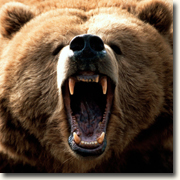
I well remember my first bear encounter when I was still a very young boy. The only bear I had ever seen prior to this encounter was a drawing in a childhood storybook in Holland. My family immigrated to Canada from Holland in the early fifties and moved to a remote hunting and fishing lodge on a lake in north-central British Columbia. My mother worked at this lodge and it was here that I was given my first job at the age of 10.
My job was to round up the horses into the corral, when needed, and to clean and smoke the fish caught by fisherman staying at the lodge. In the early fifties there was no limit on fish and most of the fisherman staying at the lodge were Americans who would charter large floatplanes and fish in the surrounding remote lakes. They would arrive back at the lodge in the early evening and unload 100-150 trout on my fish-cleaning table. I could be seen many a night outside the lodge cleaning the fish by lantern light until midnight, with the winds howling off the lake and the guests only 20 feet away inside the lodge in front of a roaring fire, drinking and telling fish stories. After I had finished cleaning all the trout I would place the majority of them into a brine ready for the smokehouse early the next morning, and the rest went into the fridge to be cooled for breakfast. Pay for my first job was 25 cents per day.
There were no other children for me to play with at this lodge so the horses were my friends, and by talking to them and feeding them carrots and extra oats we became best buddies. I learned a lot about animals from spending my time with these horses and I soon realized I had developed an instinctive, natural way with them, and I understood their behavior. (I was probably too young or stupid to show any fear). The owner of the lodge also realized how I was able catch these horses and bring them into the corral better than he could, or anyone else. If one of the guides was taking out some hunters it was now also my job to catch the horses and bring them back into the corral at the lodge. As I became more familiar with the horses it wasn't long before I could jump on the back of the oldest and tamest horse without being thrown off. I would spend all day with these animals as they grazed on the open range in the surrounding hills before returning back down to the pasture near the lodge, in the evening. I continued to upgrade myself to riding younger and faster horses until eventually I could ride a wild young mare that was the leader of the pack called "Princess".
It was one sunny afternoon in the fall when the owner of the lodge asked me to go and round up the horses that were grazing somewhere in the surrounding area of the lodge. I grabbed my short rope, which I always used to catch the horses, and a small can of oats and headed out searching for fresh horse tracks. After about an hour walking through the bush I came upon a small field and on the other side of the field was some very dense brush. I heard some rustling and when I looked in that direction, I saw something black and thought it was one of the older horses, called 'Blackie". I headed over there at a slow run and as I came close to the thick brush a big black bear, about 30 feet away, stood up and looked at me with a very surprised look on his face. I froze in my tracks and had no idea what my next move should be. Much to my surprise the bear got down on all fours and took off in the opposite direction, crashing through the bush as fast as he could go. This was my first experience with a black bear and it taught me a lot. Over the past fifty years I have traveled throughout BC to both semi-remote and very remote areas and I have encountered and studied the behavior of hundreds of black bears and many grizzlies.
During my years working in forestry and the many years purchasing rural and remote properties for my recreational land company (Niho Land & Cattle) throughout BC, I have encountered as many as eight to ten black bears a day. Many times I have been with either my wife or my sons in the bush and we have always taken necessary precautions and have never had a problem with a bear. Of all the bears that I have encountered over the years I have had to shoot only two black bears and two grizzlies. Both of the grizzlies I shot charged me while I was hunting in the high country for caribou and moose. Of the two black bears that I had to shoot, one had climbed a tree behind me and kept coming while the other was trying to get food out of my tent. I shot these bear many years ago and since then I have learnt a lot about their behavior and habits. Many a time I have been fascinated to watch, from a safe distance, a grizzly bear and sow together digging for marmots in the high country.
In my opinion, the black bear population in British Columbia has definitely increased substantially over the years. I am not sure if counts on black bears have been recorded, but from what I have seen over the past forty years, compared to now, the black bear has thrived and increased in numbers for several reasons.
1. Black bears some thirty to forty years ago were hunted for food in rural and remote areas.
2. The Queen's Royal Guards hats were made from black bear, hunted from BC, but have now been replaced with synthetic material.
3. The logging of forests have opened up entire areas and many of these areas are overgrown with berry bushes and bears love to go in and foliage on the berries.
4. The bears have become less afraid of human beings and are venturing closer and closer to civilization. I have never seen this, but have been told that a few grizzlies, if they hear a gunshot, will actually come to that area because they have learned there will be a pile of "guts" from an animal.
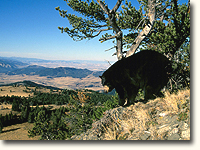 Whenever I walk through the woods, I have a conscious habit (developed over the past fifty years) to analyze the area I am in and determine what the food supply is for what animal. All animals are similar to human beings in that we both have to continually search for different food supplies depending on the time of year. We are lucky we can go to a grocery store and find vegetables in one area, fruit in another, and meat in another area. If fresh fruit is not available that time of the year we can either buy it in cans or frozen. Grizzlies living mostly in the high country, above the timberline, and hunt for marmots, carrion, caribou, elk, moose calves or small mammals. For grizzlies along the west coast of Canada and in Alaska, salmon is an important food source.
Whenever I walk through the woods, I have a conscious habit (developed over the past fifty years) to analyze the area I am in and determine what the food supply is for what animal. All animals are similar to human beings in that we both have to continually search for different food supplies depending on the time of year. We are lucky we can go to a grocery store and find vegetables in one area, fruit in another, and meat in another area. If fresh fruit is not available that time of the year we can either buy it in cans or frozen. Grizzlies living mostly in the high country, above the timberline, and hunt for marmots, carrion, caribou, elk, moose calves or small mammals. For grizzlies along the west coast of Canada and in Alaska, salmon is an important food source.
Black bears are found mostly in the low country and have a somewhat different diet than the grizzly. The black bear when he comes out of hibernation in the spring will look for the skunk cabbage. Skunk cabbage grows in very swampy wet areas and the black bear will dig up these skunk cabbages and eat the roots. The bears have a strange habit of mostly staying for a while in that same area where there is a good food supply and will not roam around. As the summer progresses, these wet areas start to dry and the black bear will begin to look for new sources of food. He will start digging up old stumps looking for insects and larvae, nuts and roots, and in summer and fall bears rely heavily on available berries. Black bears like to feed in the cool of the evening or in the early morning. During the heat of the day, they will often seek shade in the dense underbrush.
When I am walking through the woods I continually look for the food source for bear and signs or tracks of the animal. If you see any tracks it will give you an indication of the size of the bear, if she has cubs and, depending how fresh the tracks are, how long ago the bear was in the area. If you come to a field with grass you can tell by the way the grass is bent down whether a moose, deer, or bear has gone through the grass. If you step on the grass beside the trail and stand away and see how fast the grass comes up you will determine how fresh the trail that you are following is. I never walk through thick bush and will go well out of my way to stay in open areas.
The bear scat (droppings) is the best way to determine if a bear is in the area, whether it is fresh or old and what they are eating.
The habit the black bear has with skunk cabbage is that he will leave his scat mostly in one place and is tidy about it. I know to avoid skunk cabbage areas in early spring and, in the warmer weather, thick berry patches. I will make sure I avoid the black bear's grocery store. In general, adult black bears range from 35 to 40 inches tall when on all fours and have a length of 4½ to 6 feet. The weight of a black bear, which is highly variable, ranges from 125 to 600 pounds, with males (within the same geographic area) on average about a third larger than females.
The lifespan of black bears in the wild can be twenty-five years or more. I am never too worried about bears that are between one and five years old-in most cases they are scared and will quickly run the other way. It is the older bear or mother with cubs that you have to watch out for. A mother bear, if she thinks there is a threat close by, will send her cubs scattering up a tree and will stand to defend her cubs. A very old bear, like human beings, gets cranky and is less afraid of humans and can be possible trouble. It doesn't really matter if the bear weighs 180 lbs or 600 lbs-if the bear decides to attack, you will get hurt unless you know how to defend yourself.
The grizzly is a large mammal whose size and weight are extremely variable depending on the availability of food, climatic conditions, etc. In general, adult grizzlies stand approximately 3½ feet tall, or more, when on all fours and have an approximate body length of 6 ½ to 7 feet, and even up to 9 feet. The weight of grizzlies is highly variable, normally ranging anywhere from 330 to 825 pounds. Males within a geographic area may weigh more than twice as much as females. As an indication of the variability, male bears that have access to the coastal areas often weigh 1100 pounds with some individual animals weighing in excess of 1500 pounds. This is twice as heavy as the largest male black bears. Grizzlies have a heavy stout body with strong muscular legs. They have a big head, short tail, small rounded ears, feet (i.e., both heel and toe make contact with the ground when walking in a manner similar to humans), and a hind foot with five toes. They are very quick and able to attain speeds of 56 kilometers per hour 35 miles per hour for a short distance. Grizzlies have a distinctive, muscular shoulder hump, unlike a black bear, and the claws on the front paws are large, strong and slightly curved. The front claws are approximately one and three-quarter times longer than the rear claws and generally visible even from a distance. The absolute length of the front claws are often 9 centimeters (3 inches) long with claws over 12 centimeters (4¾ inches) long not uncommon. Their claws are highly adapted to digging for food (eg., tubers, rodents, etc.) as opposed to climbing.
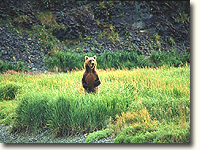 How to avoid bear attacks:
How to avoid bear attacks:
1. Food - stay away from their grocery store when walking or hiking in the forest - avoid the area of skunk cabbage, berry patches and roots, etc
2. For black bears, make lots of noise while you are walking through the bush - make sure the bears know you are coming. Most bear attacks occur when you surprise them, especially if it is a mother with her cubs or a very old cranky bear.
3. If you have a dog put him on a leash. I have seen a number of times a dog running through the woods, encountering a bear and then running back to the owner with the bear in hot pursuit.
4. If you do encounter a bear do not run-slowly back away, always watching the bear, and do not turn your back on that bear. Make yourself look as large as possible, and as confident as possible. (The latter might be a challenge!)
5. When camping, don't leave food or other attractants unattended. If you have a car close by, put the food in the trunk. Carry food and other scented items in double-bagged ziplock bags. Don't place food inside your tent but place it inside a garbage bag with your pots and pans, or backpack, and tie it with rope and loop it over a branch high up into the tree. If you are in area where there are no trees, place your food about 100 feet away from your fire with the pots and pans on top of the food and then sprinkle some cayenne pepper over top. Place your tent approximately 30 feet away from the fire on the other side. At my fire I have small kindling and I place some large logs onto the fire so they will smolder all night-so if you hear a noise, slowly get out of your tent and throw kindling on the fire to get it roaring. On a number of occasions I have woken up during the night from my pots and pans being knocked over and quickly looked out the tent to see either a bear, or in two cases wolverines, on my food. I stoke up the fire and throw some small kindling onto the fire and in most cases the animal will be scared off. (This has worked for me for bears, not for wolverines). If the bear is not going away and is determined to get your food, back away slowly and get out of the area. I remember one time a bear got a hold of a can of beans and he took it and sat about 200 feet from camp and tried everything possible to get into the can. This gave me enough time to pack up my camp and leave!
6. On two occasions when I encountered black bears that would not go away, and I had no tree to climb (and even though they are good swimmers), I have backed into a lake and the bear did not follow.
7. I do not recommend the following, except as a last resort, but I have learned the habits of black bears very well and I have used a technique for many years to determine whether or not bears were scared of me. When I run into a black bear I judge from the size of the black bear if he is young or old. I do not play with old black bears or sows with cubs, but I will with young to medium size bears. On a number of occasions I treed the bear and got many great pictures. When I encounter a bear and it doesn't run away, I do not know if he is coming to test me or not, so then I try to confuse him by not looking like a human being. Bears, like all animals, can distinguish between other animals and humans by size, smell and habits. A bear is accustomed to a human being a certain size, walking upright through the bush. What I do is hold my jacket up in my arms and try to make myself look as big as possible and kind of waddle and grunt rather than walk, so I completely disguise my size and movements to the bear. Most times when I have done this the bear just takes off full speed with a big ruff. Usually a black bear, unlike a grizzly if he is going to attack you, will not just drop on all fours and come at you full speed. The bear usually paces back and forth and grunts, stands up, comes closer and then will charge and many times will stop 30 feet away to see what you will do. If you have any food on you (e.g. jerky, chocolate bars) take this out as fast as you can and throw it as close to the bear as possible. This should provide you with some precious seconds to escape. I believe the bear is testing to see if you are scared or pose any threat to him. If you see a bear standing up grunting and running at you, then stopping and circling, he could possibly attack. I would suggest at this time you decide whether to climb a tree, keep backing away slowly or throw rocks and sticks at him.
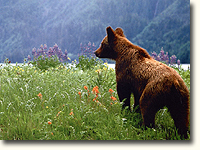 8. Climbing a tree would be my next choice and you need to consider the distance between you and the bear and the distance to the nearest climbable tree. A bear can cover 50 yards in about 3 seconds! Black bears will climb trees and on the two occasions that I climbed trees, the bears came after me. One time I had no gun so I urinated on the bear, which slowed him down somewhat, and I managed to kick him hard on the nose with my boot. The second time the bear came up the tree after me, I happened to have a pistol with me so I shot the bear when I realized he was continuing to climb after me. But you have to make sure the trees have lots of branches so you can climb fairly fast because a bear is a good climber and does not need any branches. You will be able to maneuver around the branches better than the bear so if you can find a big old spruce tree with lots of big branches, climb it! But if you have to shimmy up a tree with no branches the bear will beat you ten times over. However, you are better off being up a tree than tackling the bear on open ground. While in the tree kick your feet, urinate on the bear and try to break a branch off and hit him on the nose with it, or if you have to, poke him in the eye.
8. Climbing a tree would be my next choice and you need to consider the distance between you and the bear and the distance to the nearest climbable tree. A bear can cover 50 yards in about 3 seconds! Black bears will climb trees and on the two occasions that I climbed trees, the bears came after me. One time I had no gun so I urinated on the bear, which slowed him down somewhat, and I managed to kick him hard on the nose with my boot. The second time the bear came up the tree after me, I happened to have a pistol with me so I shot the bear when I realized he was continuing to climb after me. But you have to make sure the trees have lots of branches so you can climb fairly fast because a bear is a good climber and does not need any branches. You will be able to maneuver around the branches better than the bear so if you can find a big old spruce tree with lots of big branches, climb it! But if you have to shimmy up a tree with no branches the bear will beat you ten times over. However, you are better off being up a tree than tackling the bear on open ground. While in the tree kick your feet, urinate on the bear and try to break a branch off and hit him on the nose with it, or if you have to, poke him in the eye.
9. If there are no trees around and you have a bear that you think is planning to attack, start throwing everything you can at him rocks, sticks, branches-yell and keep backing away slowly while continuing to yell and throw things at him. Do not panic-turnaround and run.
10. I would not suggest this, but if a bear does attack you and you are being bitten and swatted, you have two choices-play dead or fight. Some say to play dead, and this has worked in a number of cases. However, in other cases the bear has killed that person. I usually always carry a razor sharp 7-inch buck knife and I would fight until my last breath and try to get one good stab into the eye or the belly rather than take the chance of him leaving me alone if I play dead.
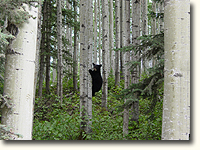 I had an instance where a large grizzly bear came between me and a bull caribou that I had shot the day before. I realized too late that the grizzly had moved in, claimed the caribou carcass and was presently in the immediate area. The open terrain left nowhere to go but up a very steep cliff approximately 200 feet away, so I cautiously made my way there, put my back against the cliff and sat with my rifle, watching the caribou. I did not want to be caught in the open with a light caliber rifle. At that time I thought the grizzly would come out, take the caribou and then disappear.
I had an instance where a large grizzly bear came between me and a bull caribou that I had shot the day before. I realized too late that the grizzly had moved in, claimed the caribou carcass and was presently in the immediate area. The open terrain left nowhere to go but up a very steep cliff approximately 200 feet away, so I cautiously made my way there, put my back against the cliff and sat with my rifle, watching the caribou. I did not want to be caught in the open with a light caliber rifle. At that time I thought the grizzly would come out, take the caribou and then disappear.
Unknown to me, the grizzly came down behind me on the steepest rock face I had ever seen and never made a sound. I finally gave up waiting for him and thought I would take a picture of the caribou and a cut of the hindquarter, before leaving. I backed up to take the picture, looked through the camera and saw this enormous grizzly standing full height.
I froze in my tracks. I took the safety off my gun, but I did not want to shoot for two reasons; one I do not like to shoot grizzlies and two, the caliber was very light and it would take an excellent shot to take the grizzly down. The grizzly continued to circle me and then charged at full speed. I realized I had no choice but to shoot so I brought my rifle up but my scope was completely fogged up and the grizzly was almost upon me. I fired a shot up in the air, and to this day I have no idea what went through the grizzly's mind, but he went passed me and missed me by six feet and kept on going full speed for a quarter of mile and disappeared in some dense brush.
Bear protection-there are a number of weapons you can carry with you in the woods.
1. Shotgun or Rifle: If I have to go into very heavy bear country and if I am not by myself or have one of my family members with me, I will carry a small 12 gauge shotgun. I prefer this to a rifle, which would be my second choice. My shotgun holds six rounds, so the first two rounds I use are slugs which have single, large lead bullets, the next two shells consist of about five pellets each, and the last two shells contain about twenty pellets each. A shotgun at close range is the most deadly weapon there is. To carry this type of gun you require a firearm license.
2. Bear Bangers: There are a number of bear bangers on the market, in various sizes. The smallest one looks like a fountain pen and when you screw in what looks like a shotgun shell, it creates a firing device that, when pulled back and let go, hits the cap and sends out a projectile which then explodes with a terrific bang. I have never tried it on a bear but you would not want to land this projectile on the other side of a bear as it would make the bear come running directly towards you.
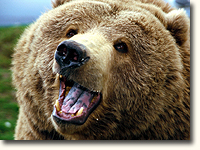 3. Bear Spray: There are a number of bear repellants that have a Capsaicin pepper in them. For this to work you would have to be very calm and brave to stand within 15-25 feet of the bear and try to spray him in the face. If a bear is coming at you at 25 miles per hour, spraying him at 25 feet will not stop him, but this would be better than having nothing at all with which to fight. The drawback to this would be that, if the wind is blowing towards you, the spray could end up in your face and you would be in worse condition than the bear. I have talked to a number of people who have used this spray on bears and they said it did not work very well. Effectiveness can depend on the weather, size of the can, delivery pattern, distance to target and loss of potency of the spray.
3. Bear Spray: There are a number of bear repellants that have a Capsaicin pepper in them. For this to work you would have to be very calm and brave to stand within 15-25 feet of the bear and try to spray him in the face. If a bear is coming at you at 25 miles per hour, spraying him at 25 feet will not stop him, but this would be better than having nothing at all with which to fight. The drawback to this would be that, if the wind is blowing towards you, the spray could end up in your face and you would be in worse condition than the bear. I have talked to a number of people who have used this spray on bears and they said it did not work very well. Effectiveness can depend on the weather, size of the can, delivery pattern, distance to target and loss of potency of the spray.
4. Knife: I never go into the woods unless I carry my buck knife, which I keep razor sharp. It is recommended that if you have to fight a bear and it is your last resort, have the knife attached with a cord to your wrist so you avoid having the knife thrown from your reach by the swatting bear.
I had a friend who was hunting for black bear and he wounded one that went into the thick bush. Never enter bush after a bear, especially a wounded bear, because they move extremely well in the bush, and humans don't. My friend entered the dense bush and the bear came up behind him and struck him twice, sending his rifle flying. The bear then proceeded to maul and sink its teeth into his shoulder. He managed to get his buck knife free and pushed the knife into the bear's stomach. The bear kept biting and dragging him away, but with a second strike he managed to get his knife into the throat and then killed the bear. Over 100 stitches were required to repair his wounds. My friend has learned his lesson and will never go into the bush after a wounded bear again.
My brother is an experienced guide who lost one of his long time employees last year when the guide broke a golden rule and went into thick bush after a wounded grizzly. The bear attacked him before he managed to fire a shot and mauled him to death.
I believe the black bear population is continuing to increase every year and they are now less afraid of humans than ever before. But we have to learn how to live with each other. All the precautionary methods possible should be taken when entering a bear's territory.
Each year several people are attacked by grizzly bears, but it should be noted, only five people have been killed by grizzly bears in B.C. since 1978. While, most black bears are more likely to run away from a human than attack, the number of people attacked by black bears in the province each year is about the same as the number attacked by the less abundant grizzly. By contrast, there were 110 homicides in B.C. in 1999 (humans killing humans) and there were 85 in 2000
Contact Information: #200 - 313 Sixth Street, New Westminster, BC V3L 3A7 CANADA
Telephone: 604-606-7900 | Email: [email protected]
Copyright © 2012 Niho Land & Cattle Company. All rights reserved. | Privacy Policy | Terms of Use | Webmaster

